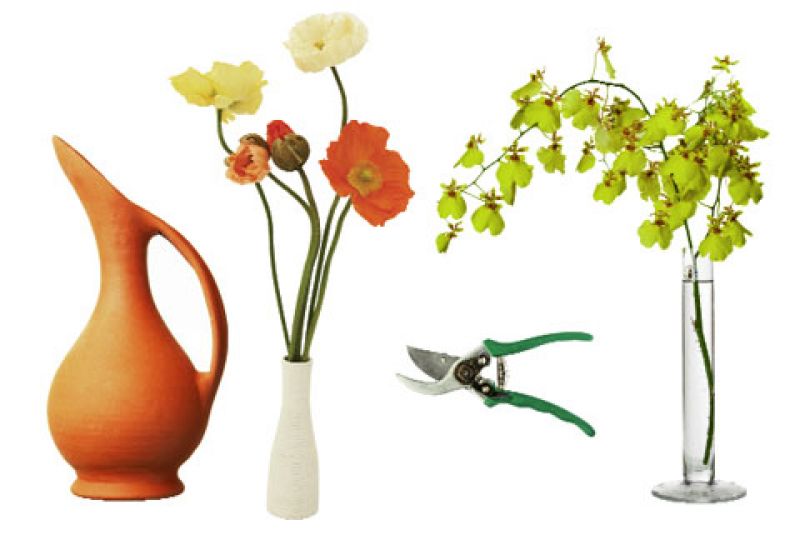
Select Your Blooms: Before you make a trip to the store, take a walk through the neighborhood. “Among local flowers, gardenias and ginger lilies are among my all-time favorites—they have the most intoxicating scents. Hydrangeas can be found nearly year-round, and sweet olive is a nice evergreen choice. I use ferns and palms to add a tropical island air to more formal arrangements.”
Tip: Think outside the box and get creative with what you have—even bark, moss, and other elements of nature can make chic additions to an unconventional arrangement.
Choose the Right Container: An unusual vase can up the impact of even a simple arrangement, but choose one defined by intriguing shape or texture rather than color. “Bold hues—even a bright white—can detract from flowers’ natural beauty. For more basic containers, I prefer square vases to circular ones because they offer a nice contrast to the round, full arrangements that I love.”
Tip: If you want to use a clear container, tie stems neatly in a bundle or hide them by lining the inside of the vase with large leaves. For a quick and creative fix, tuck the vase into a basket or other decorative container.
Determine the Height: “Generally, you should cut flowers and greenery so that they are double the height of your container.” Of course, there are exceptions: a squat arrangement in which the flowers just peek over the rim of the container is great for a table centerpiece, for example.
Tip: Use sharp scissors to cut your stems. An even cut allows water to enter the stems, while a ragged edge can inhibit them from drawing in water and cause them to fade faster.
Easy Does It: Lacking in arrangement inspiration? Place a single Casablanca lily or orchid in a bud vase—line a few up in a row for an elegant centerpiece, or use just one to brighten a side table. Camellias or gardenias plucked from the garden can also look lovely floating in a wine glass, teacup, or other low dish.
Tip: Lilies are notorious for their pollen, which can not only stain fabric, but leave orange smears on flower petals as well. To avoid a mess, cut off the stamen at the bloom’s center as soon as the flower opens.
Make Them Last: Change the water in your arrangement every other day, or when it starts to look cloudy. For a display too carefully crafted to be uprooted, just make sure water stays at a consistently high level. Revitalize droopy flowers by refrigerating overnight.
Tip: Strip stems of any leaves that will be below the water line—this will decrease bacteria levels.
About Floral Foam: Floral foam is useful in containers that aren’t deep enough to hold much water or support tall stems. While most flowers and greenery work well with floral foam, wide branches can break through it, and weak-stemmed flora like calla lilies aren’t strong enough to stand up in it.
Tip: When working with floral foam, be sure you have a plan for concealing any that’s still visible once you complete your arrangement. Try using blooms like mums or daisies to create a tight groundcover over its surface.